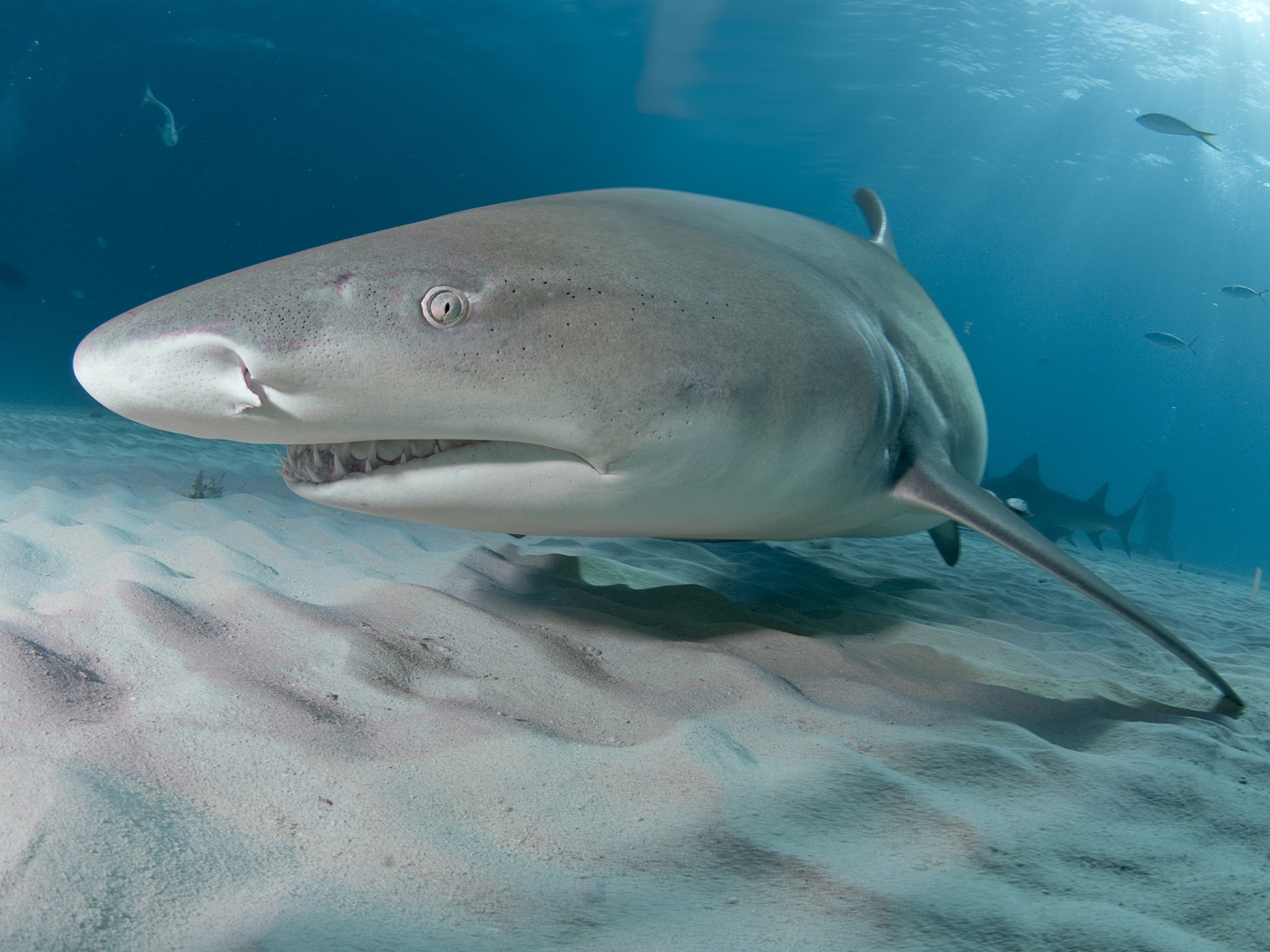Fast-food consumables like french fries are known to come in "super-size." According to Hollywood, tsunamis do also. But is there scientific evidence for super-size tsunamis in the past? The Indian Ocean tragedy has brought attention to the fact that these large water waves rank among earth's most severe natural disasters. Because water is incompressible, disturbance at the ocean floor generates a surface wave. In deep water such waves propagate at speeds (celerity) as high as 800 kilometers per hour, and their passage through the deep ocean is barely perceptible. As water depths shallow, however, wave energy becomes packed into a smaller column of water, the wave slows, or "shoals," and its form builds to fearsome proportions.
The Indian Ocean Tsunami of 2004
The catastrophe began on December 26, 2004, with a magnitude 9.0 earthquake in the deep-water Sunda Trench offshore Sumatra. Within 3-4 minutes, a 1200 kilometer-long rupture opened the seafloor, and a region roughly the length and half the width of California was displaced vertically by about two meters. The work involved is a measure of the raw energy imparted to the tsunami. In this case, it was equivalent to about 100 Hiroshima-sized atomic bombs.1
Directly east of the epicenter lies the coastline of Sumatra's Aceh province which experienced wave run-ups as high as 30 meters above sea level (height of a ten-story building). Across the Indian Ocean, the Sri Lanka coast received devastating waves with run-ups to 10 meters. Hollywood imagery of steep-fronted and curling waves may appear spectacular, but are generally not true. Rather, tsunamis are best likened to an advancing plateau of water, and the shape of the wave front has probably less significance than the mass of water behind it. Both the rushing waves and receding waves do geologic work, creating distinctive sedimentary deposits.
Earthquake-generated Waves
Four mechanisms are responsible for most, if not all, tsunamis: earthquake, landslide, volcano, or extraterrestrial impact. The Indian Ocean tsunami was an example of the earthquake-generated type, but there have been many others. In 1755 a big wave struck Lisbon, Portugal, following an estimated 8.7M earthquake that reduced that nation's shipping industry and navy to a shambles overnight. A seismically active deep-sea trench very similar to the Sunda Trench seems poised off the Washington-Oregon coast. Evidence for several tsunami strikes over the past few hundred years has been found by geologists in the coastal marshes of the Pacific Northwest.2 The tsunamis in these cases were probably comparable in size to the December 26, 2004, Indian Ocean event.
Shallow-focus earthquakes, the kind that generate most tsunamis, seem to be size and energy limited. Deep-focus earthquakes, on the other hand, are generated by an entirely different process. Low density minerals (like olivine) can transform to higher-density minerals (like spinel and perovskite), abruptly changing the volume of rocks.3 Volume reduction associated with this sudden phase-change is capable of delivering an immense seismic jolt. Historic deep-focus earthquakes may represent mere residual stresses left over from much greater, planet-wide plate movements that are modeled to have accompanied the Genesis Flood. Magnitude-13 earthquakes and greater are conceivable during this time of theoretical whole-mantle overturn.4 Herein lies a mechanism for generating "super-size" tsunamis in the past.
Landslide-generated Waves
Big waves that struck the sparsely populated Newfoundland coast in 1929 and the north coast of Papua New Guinea in 1998 testify to landslide processes. Landslide scarps and debris deposits from both tsunamis have been located on the ocean floor.5 Thus, the evidence for past tsunamis can be found by wash marks on shore, or, indirectly, in the form of large landslides, scarps, and debris piles lying on the deep ocean floor.
Landslide debris covers the mostly underwater Hawaiian Ridge over an area that is five times greater than the area of the Hawaiian Islands themselves.6 Individual landslides have been identified that are as large as 17,000 cubic kilometers. Underwater mapping reveals a lumpy appearance to the deposits that is strikingly similar to that left by the 1980 Mount St. Helens landslide, only 1000 times larger. These landslides must have traveled underwater at speeds on the order of 100 kilometers per hour and unquestionably caused monstrous tsunamis. But how big were they? Basalt cobbles and reef debris found 375 meters above present sea level on the island of Lanai, testify that waves ten times the height of those that recently struck Sumatra washed the debris onto the Hawaiian mountainsides. Similar landslide debris offshore from both New Jersey and Oregon testify of enormous past tsunamis that struck the U.S. mainland.7
The largest landslide-generated tsunami appears to have occurred when the entire continental shelf surrounding the Gulf of Mexico gave way, and produced 200-meter-plus tsunamis across that region.8 The trigger for this simultaneous collapse across such a large area is postulated to have been the Chicxulub (extraterrestrial) impact on Mexico's Yucatan peninsula. Some of North America's largest oilfields owe their existence to sediments moved by this tsunami.9 Oilfield geologists take catastrophic geology seriously in the Gulf region.
Volcanic-collapse Generated Waves
Large composite-cone volcanoes usually collapse inward after eruption and form a crater like depression called a caldera. If near sea level, the sudden rush of ocean waters into a hot and instantly formed caldera can generate impressive tsunamis. The crater left by the explosion of Krakatoa (1883) in Indonesia's Sunda Strait measures about 5 kilometers by 6 kilometers. The sudden infilling of this caldera with seawater is the probable cause for tsunami wave runups of 37 meters on neighboring coastlines that killed 36,000 people. Santorini Volcano in the Aegean Sea erupted explosively around 1490 B.C., and left a caldera of about 8 by 11 kilometers, over ten times the collapsed volume of Krakatoa. Sea-borne pumice deposits 250 meters above sea level on the nearby island of Anaphi, and an unusual deep-sea deposit tens of meters thick across much of the eastern Mediterranean, have both been attributed to the Santorini tsunami.10 Globally, at least 37 volcanic craters are known to be more than ten times bigger than Santorini and Krakatoa, and many of these are found at, or near sea level.11 Certainly volcanic-collapse generated waves, including some of super-size, played a major role in earth history.
Impact-generated Waves
Craters and suspected craters have been found in continental margins that record at least 18 large asteroid or comet impact events.12 Despite the lack of historical precedent, tsunamis of potentially super-size by impact have occurred in the past. The 90-kilometer-diameter Chesapeake Bay structure lies beneath 400-500 meters of coastal sediments in northeastern Virginia.13 Seismic imagery reveals a near circular crater as deep as Grand Canyon and encompassing an area twice that of Rhode Island. Waters that rushed into this instantly formed crater must have generated outward-bound waves with initial or "primary" heights of up to 500 meters, modeling predicts, which probably put the Appalachian foothills underwater.
Impacts of much larger proportions struck when most of the continent was under water, probably during Noah's Flood. Across a 10,000 square kilometer area in southern Nevada, disrupted limestone blocks and as many as five graded beds occur, as if great tsunamis sorted debris by size.14 The Manson impact structure, located in north-central Iowa, also took place when the continent was underwater, and is associated with a widespread limestone tsunami deposit.15
Do Tsunamis Have a Size Limit?
Life on our blue planet has had to cope with tsunamis of super-size, even in human history. Science has discovered this fact. What is the size limit for tsunamis? An ancient text says, "In the six hundredth year of Noah's life, in the second month, the seventeenth day of the month, the same day were all the fountains of the great deep broken up, and the windows of heaven were opened" (Genesis 7:11). The text provides the date, the duration, the depth and the extent of a seafloor disturbance that began a Flood affirmed to be worldwide by the prophet Moses, the Lord Jesus Christ, and the apostle Peter. If this really happened in the fabric of space-time history, it surely would have created the greatest of tsunamis. As the people of South Asia pick up the pieces from the Indian Ocean catastrophe, perhaps they will discover a new and unique perspective on this passage of Scripture. May they find the Ark of salvation that is in the Lord Jesus Christ.
Endnotes
- Tsunami energy of 8 x 1015 joules is estimated from disturbance map in: Science News, Jan. 8, 2005. Total energy of the earthquake is 2 x 1018 joules.
- Atwater, B. F., 1987, Evidence for great Holocene earthquakes along the outer coast of Washington state: Science, 236:942-944.
- Dabler, R., and D. Yuen, 1996, The metastable olivine wedge in fast subducting slabs: Constraints from thermo-kinetic coupling: Earth and Planetary Science Letters, 137:109-118.
- Baumgardner, J., 2003, Catastrophic plate tectonics: The physics behind the Genesis Flood, in R. L. Ivey, editor: Proceedings of the Fifth International Conference on Creationism, Creation Science Fellowship, Pittsburgh, PA, pp. 113-126, also in http://globalflood.org.
- 5Monastersky, R., 1998, Waves of death: why the New Guinea tsunami carries bad news for North America: Science News, Oct. 3, 1998.
- Normark, W. R., and others, 1993, Giant volcano-related landslides and the development of the Hawaiian Islands: United States Geological Survey Bulletin, 2002:184-196.
- Driscoll, N. W., and others, 2000, Potential for large-scale submarine slope failure and tsunami generation along the U.S. mid-Atlantic coast: Geology, 28:407-410; and C. Goldfinger, and others, 2000, Super-scale failure of the southern Oregon Cascadia margin: Pure and Applied Geophysics, 157:1189-1226.
- Bralower, T. J., and others, 1998, Cretaceous-Tertiary boundary cocktail: Chicxulub impact triggers margin collapse and extensive sediment gravity flows: Geology, 26:331-334.
- Including the giant Canterell field (17 billion barrels, original reserves) and others in Mexico's prolific Campeche Platform: J. M. Grajales-Nishimura and others, 2000, Chicxulub impact: The origin of reservoir and seal facies in the southeastern Mexico oil fields: Geology, 28:307-310.
- Yokoyama, I., 1978, The tsunami caused by the prehistoric eruption of Thera, in Thera and the Aegean World I: Santorini, Greece, Second International Scientific Congress, pp. 277-283; and M. Cita, and others, 1996, Deep-sea tsunami deposits in the eastern Mediterranean: new evidence and depositional models: Sedimentary Geology, 104:155-173.
- Mason, B., and others, 2004, The size and frequency of the largest explosive eruptions on earth: Bulletin of Volcanology, 66:735-748.
- Dypvik, H., and L. Jansa, 2003, Sedimentary signatures and processes during marine bolide impacts: a review: Sedimentary Geology, 161:309-337.
- Poag, C. W., and others, eds., 2004, The Chesapeake Bay Crater: Springer, New York, 522 pp.
- Warme, J. E., and H. C. Kuehner, 1998, Anatomy of an anomaly: The Devonian catastrophic Alamo impact breccia of southern Nevada: International Geology Review, 40:189-216.
- Hartung, J. B., and R. R. Anderson, 1996, A brief history on investigations of the Manson impact structure, Geological Society of America, Special Paper 302, pp. 31-43.



















